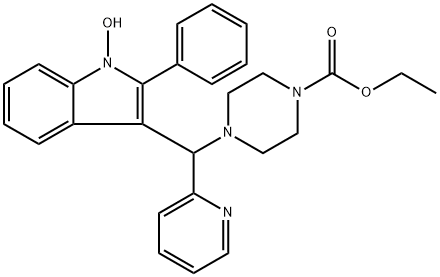|
|
| | PIP-199 Basic information |
| Product Name: | PIP-199 | | Synonyms: | PIP-199;PIP-199 ethyl 4-((1-hydroxy-2-phenyl-1H-indol-3-yl)(pyridin-2-yl)methyl)piperazine-1-carboxylate;1-Piperazinecarboxylic acid, 4-[(1-hydroxy-2-phenyl-1H-indol-3-yl)-2-pyridinylmethyl]-, ethyl ester;ethyl 4-[(1-hydroxy-2-phenyl-1H-indol-3-yl)(pyridin-2-yl)methyl]piperazine-1-carboxylate | | CAS: | 622795-76-0 | | MF: | C27H28N4O3 | | MW: | 456.55 | | EINECS: | | | Product Categories: | | | Mol File: | 622795-76-0.mol |  |
| | PIP-199 Chemical Properties |
| Boiling point | 655.1±65.0 °C(Predicted) | | density | 1.26±0.1 g/cm3(Predicted) | | storage temp. | Store at -20°C | | pka | 13.19±0.58(Predicted) | | form | Solid | | color | White to off-white |
| | PIP-199 Usage And Synthesis |
| Biological Activity | PIP-199 is a selective inhibitor of the RecQ-mediated RMI core complex/MM2 interaction of genomically unstable proteins with IC50 of 36 μM. PIP-199 can be used to sensitize resistant tumors to DNA cross-linking chemotherapeutics. | | in vitro | MM2 is the binding site of RMI complex on Fanconi anemia complementation group M protein (FANCM).
Induction of the Fanconi anemia (FA) DNA repair pathway is a common mechanism by which tumors evolve resistance to DNA crosslinking chemotherapies.
Proper execution of the FA pathway requires interaction between the FANCM and the RMI complex, and mutations that disrupt FANCM/RMI interactions sensitize cells to DNA crosslinking agents.
| | target | IC50: 36 μM (RMI core complex/MM2 interaction) |
| | PIP-199 Preparation Products And Raw materials |
|